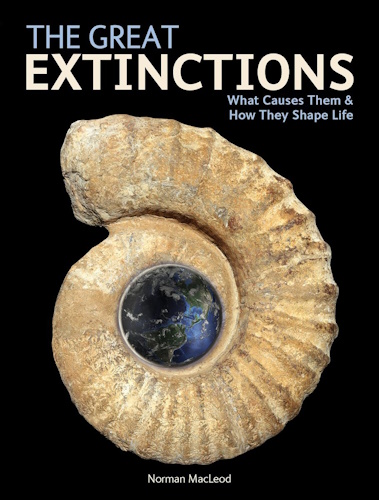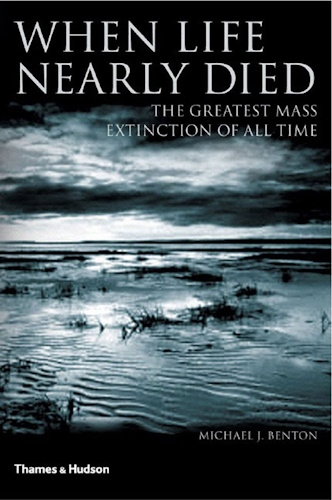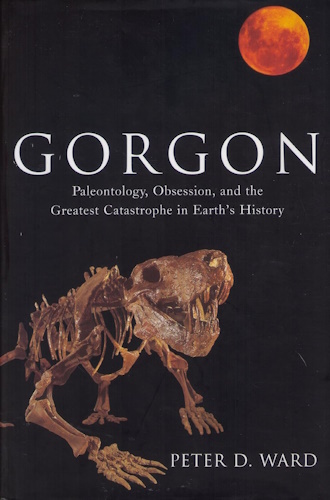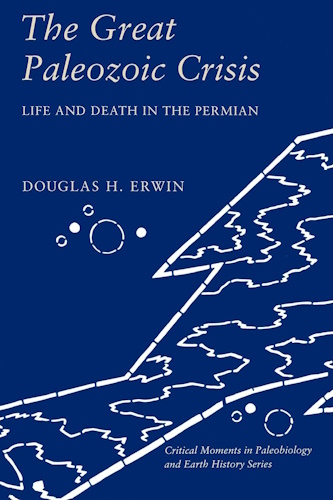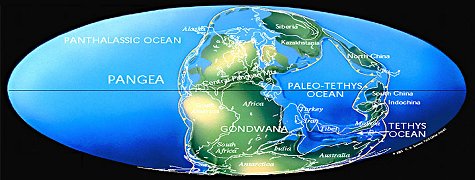![]()
![]()
250 million years ago something unknown wiped out most life on our planet. Now scientists are finding buried clues to the mystery inside tiny capsules of cosmic gas.
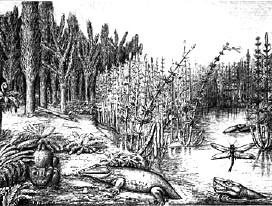
Lower Permian swamp in Texas
It was almost the perfect crime.
Some perpetrator -- or perpetrators -- committed murder on a scale unequaled in the history of the world. They left few clues to their identity, and they buried all the evidence under layers and layers of earth.
The case has gone unsolved for years -- 250 million years, that is.
But now the pieces are starting to come together, thanks to a team of NASA-funded sleuths who have found the "fingerprints" of the villain, or at least of one of the accomplices.
Above: Life was flourishing on the Earth about 250 million years ago, then during a brief window of geologic time nearly all of it was wiped out. This image is an artist's impression of a Lower Permian swamp in Texas.
The terrible event had been lost in the amnesia of time for eons. It was only recently that paleontologists, like hikers stumbling upon an unmarked grave in the woods, noticed a startling pattern in the fossil record: Below a certain point in the accumulated layers of earth, the rock shows signs of an ancient world teeming with life. In more recent layers just above that point, signs of life all but vanish.
Somehow, most of the life on Earth perished in a brief moment of geologic time roughly 250 million years ago. Scientists call it the Permian-Triassic extinction or "the Great Dying" -- not to be confused with the better-known Cretaceous-Tertiary extinction that signaled the end of the dinosaurs 65 million years ago. Whatever happened during the Permian-Triassic period was much worse: No class of life was spared from the devastation. Trees, plants, lizards, proto-mammals, insects, fish, mollusks, and microbes -- all were nearly wiped out. Roughly 9 in 10 marine species and 7 in 10 land species vanished. Life on our planet almost came to an end.
Scientists have suggested many possible causes for the Great Dying: severe volcanism, a nearby supernova, environmental changes wrought by the formation of a super-continent, the devastating impact of a large asteroid -- or some combination of these. Proving which theory is correct has been difficult. The trail has grown cold over the last quarter billion years; much of the evidence has been destroyed.
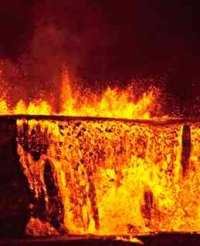
Left: The Earth was engulfed in widespread volcanism at the time of the extinction. Photo courtesy Dick Rasp/National Park Service.
"These rocks have been through a lot, geologically speaking, and a lot of times they don't preserve the (extinction) boundary very well," says Luann Becker, a geologist at the University of California, Santa Barbara. Indeed, there are few 250 million-year-old rocks left on Earth. Most have been recycled by our planet's tectonic activity.
Undaunted, Becker led a NASA-funded science team to sites in Hungary, Japan and China where such rocks still exist and have been exposed. There they found telltale signs of a collision between our planet and an asteroid 6 to 12 km across -- in other words, as big or bigger than Mt. Everest.
Many paleontologists have been skeptical of the theory that an asteroid caused the extinction. Early studies of the fossil record suggested that the die-out happened gradually over millions of years -- not suddenly like an impact event. But as their methods for dating the disappearance of species has improved, estimates of its duration have shrunk from millions of years to between 8,000 and 100,000 years. That's a blink of the eye in geological terms.
"I think paleontologists are now coming full circle and leading the way, saying that the extinction was extremely abrupt," Becker notes. "Life vanished quickly on the scale of geologic time, and it takes something catastrophic to do that."
Such evidence is merely circumstantial -- it doesn't actually prove anything. Becker's evidence, however, is more direct and persuasive:
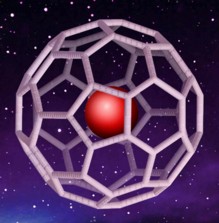
Deep inside Permian-Triassic rocks, Becker's team found soccer ball-shaped molecules called "fullerenes" (or "buckyballs") with traces of helium and argon gas trapped inside. The fullerenes held an unusual number of 3He and 36Ar atoms -- isotopes that are more common in space than on Earth. Something, like a comet or an asteroid, must have brought the fullerenes to our planet.
Above: The carbon atoms in a fullerene molecule are arranged in a spherical pattern similar to a geodesic dome. (Geodesic domes were invented by Buckminster Fuller, hence the name of the molecules.) This shape allows the fullerenes to trap gases inside. Image courtesy Luann Becker.
Becker's team had previously found such gas-bearing buckyballs in rock layers associated with two known impact events: the 65 million-year-old Cretaceous-Tertiary impact and the 1.8 billion-year-old Sudbury impact crater in Ontario, Canada. They also found fullerenes containing similar gases in some meteorites. Taken together, these clues make a compelling case that a space rock struck the Earth at the time of the Great Dying.
But was an asteroid the killer, or merely an accomplice?
Many scientists believe that life was already struggling when the putative space rock arrived. Our planet was in the throes of severe volcanism. In a region that is now called Siberia, 1.5 million cubic kilometers of lava flowed from an awesome fissure in the crust. (For comparison, Mt. St. Helens unleashed about one cubic kilometer of lava in 1980.) Such an eruption would have scorched vast expanses of land, clouded the atmosphere with dust, and released climate-altering greenhouse gases.
Above: What the world looked like 250 million years ago. Image credit: Chris Scotese. [ more]
World geography was also changing then. Plate tectonics pushed the continents together to form the super-continent Pangea and the super-ocean Panthalassa. Weather patterns and ocean currents shifted, many coastlines and their shallow marine ecosystems vanished, sea levels dropped.
"If life suddenly has all these different things happen to it," Becker says, "and then you slam it with a rock the size of Mt. Everest -- boy! That's just really bad luck."
Was the "crime" then merely an accident? Perhaps so. Nevertheless, it's wise to identify the suspects -- an ongoing process -- before it happens again.
Editor's note: Becker's colleagues include Robert Poreda and Andrew Hunt from the University of Rochester, NY; Ted Bunch of the NASA Ames Research Center; and Michael Rampino of New York University and NASA's Goddard Institute of Space Sciences. Funding for the research was provided by NASA's Astrobiology and Cosmochemistry programs and the National Science Foundation.
|
Credits & Contacts Author: Patrick L. Barry Responsible NASA official: John M. Horack |
Production Editor: Dr. Tony Phillips Curator: Bryan Walls Media Relations: Steve Roy |
|
The Science and Technology Directorate at NASA's Marshall Space Flight Center sponsors the Science@NASA web sites. The mission of Science@NASA is to help the public understand how exciting NASA research is and to help NASA scientists fulfill their outreach responsibilities. |
|
![]()
![]()
Disclaimer:
Some material presented will contain links, quotes, ideologies, etc., the contents of which should be understood to first, in their whole, reflect the views or opinions of their editors, and second, are used in my personal research as "fair use" sources only, and not espousement one way or the other. Researching for 'truth' leads one all over the place...a piece here, a piece there. As a researcher, I hunt, gather and disassemble resources, trying to put all the pieces into a coherent and logical whole. I encourage you to do the same. And please remember, these pages are only my effort to collect all the pieces I can find and see if they properly fit into the 'reality aggregate'.
Personal Position:
I've come to realize that 'truth' boils down to what we 'believe' the facts we've gathered point to. We only 'know' what we've 'experienced' firsthand. Everything else - what we read, what we watch, what we hear - is what someone else's gathered facts point to and 'they' 'believe' is 'truth', so that 'truth' seems to change in direct proportion to newly gathered facts divided by applied plausibility. Though I believe there is 'truth', until someone representing the celestial realm visibly appears and presents the heavenly records of Facts And Lies In The Order They Happened, I can't know for sure exactly what "the whole truth' on any given subject is, and what applies to me applies to everyone. Until then I'll continue to ask, "what does The Urantia Book say on the subject?"
~Gail Bird Allen
![]()
![]()

